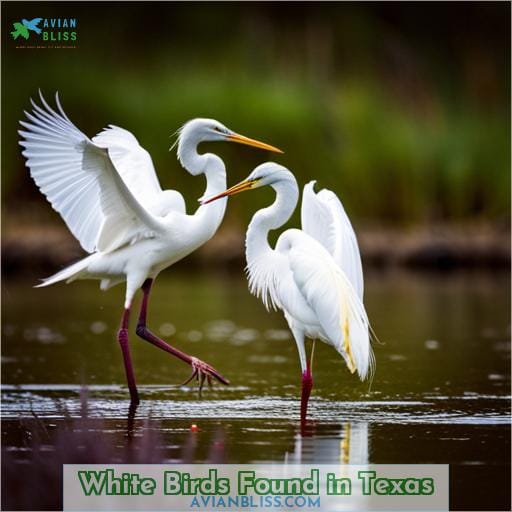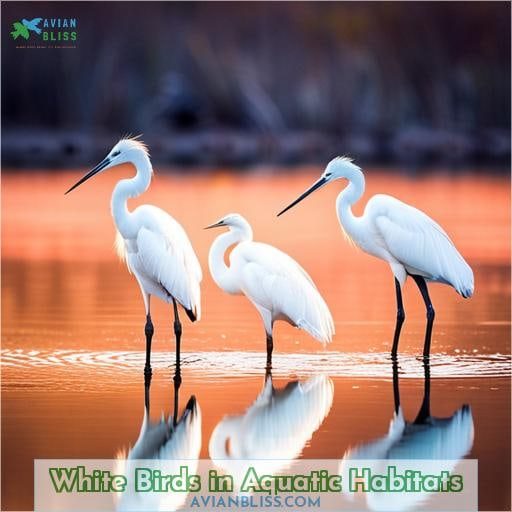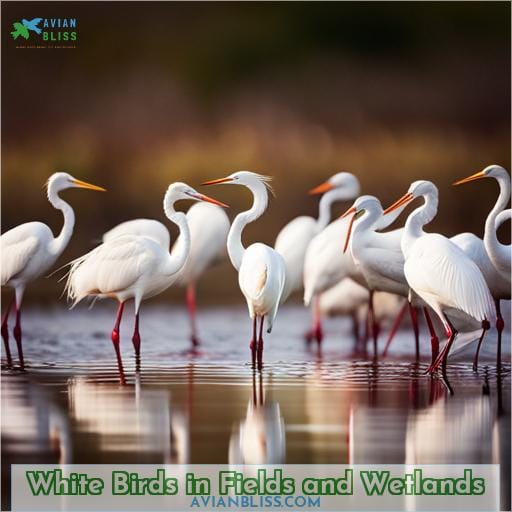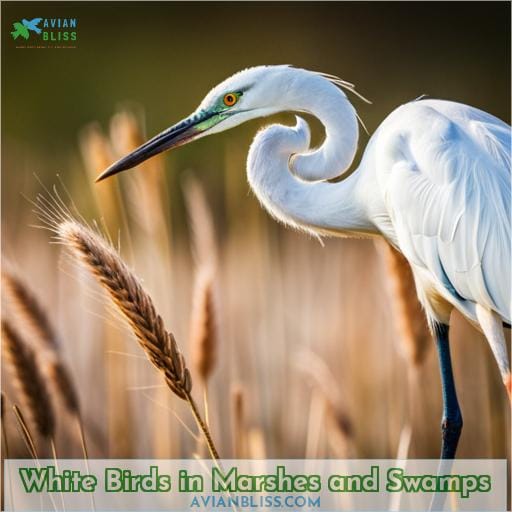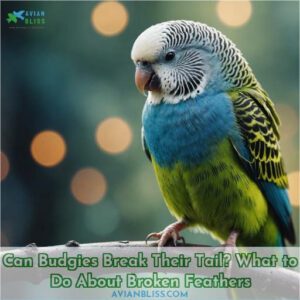This site is supported by our readers. We may earn a commission, at no cost to you, if you purchase through links.
 As the sun rises over Texas, it illuminates a stunning array of white birds – from majestic egrets to dazzling pelicans. If you find yourself wondering which white bird you just saw, this guide will help illuminate your curiosity like a lighthouse in the night.
As the sun rises over Texas, it illuminates a stunning array of white birds – from majestic egrets to dazzling pelicans. If you find yourself wondering which white bird you just saw, this guide will help illuminate your curiosity like a lighthouse in the night.
Here we’ll explore 19 different types of white birds found in Texas; their habitats, behaviors and identification tips that will make them stand out from one another like snowflakes on a winter day.
From Rock Pigeons commonly seen gathering around urban areas to Trumpeter Swans honking across wetlands or Ross’s Geese migrating through fields – there’s an abundance of beautiful white birds waiting for discovery within our Lone Star State!
Table Of Contents
- Key Takeaways
- White Birds Found in Texas
- White Birds With Albinism or Leucism
- Common White Birds in Urban Areas
- White Birds in Aquatic Habitats
- Large White Birds With Unique Characteristics
- White Birds in Fields and Wetlands
- Impressive Large White Birds
- Migratory White Birds
- Distinctive White Birds of Prey
- White Birds in Marshes and Swamps
- Conclusion
Key Takeaways
- White birds are common in urban areas in Texas.
- Some white birds in Texas exhibit albinism or leucism, genetic conditions that cause a lack of pigmentation.
- Conservation efforts are vital for preserving populations of white birds native to Texas.
- The Great Egret, a stately white wading bird, has rebounded in Texas after being threatened by habitat loss and the plume-hunting trade in the late 19th and early 20th centuries.
White Birds Found in Texas
Texas is home to several beautiful white birds that can be seen throughout the state. The Rock Pigeon, Ring-Billed Gull, Great Egret, and other white birds can be observed in urban areas, fields, lakes, wetlands, and coastal regions of Texas.
Rock Pigeon
You can always spot a Rock Pigeon pecking around city parks. Yet their iridescent feathers can catch your eye like hidden treasure among the concrete. As an urban bird, the Rock Pigeon thrives in populated areas, blending into the urban landscape.
Seeking scattered crumbs and seeds, pigeons gather where people congregate, becoming a familiar fixture of city life. Adaptable and resourceful, they build nests and raise young on ledges under bridges, in nooks on buildings, or any sheltered site.
Ring-Billed Gull
My friend, the ring-billed gull floats on lakes like a ballerina dancing across a stage, preferring aquatic habitats near freshwater while displaying its gray feathers and distinctive white head. Adept at catching fish, it plunges from graceful flight to snatch prey. Though small, it migrates astonishing distances.
We must continue conservation efforts for the habitats on which it depends during migrations between its breeding and wintering grounds.
Great Egret
The majestic Great Egret stands tall with its elegant white plumage and iconic s-shaped neck, evoking a sense of awe as it fishes the shallow wetlands. Known for spearing fish and frogs with its sharp yellow bill, these large herons inhabit marshes and ponds across Texas.
Though once endangered from plume hunting, great egrets have rebounded. You may spot these striking birds feeding methodically or wading gracefully through wetlands. With ongoing conservation efforts, these magnificent great egrets can continue inhabiting Texas wetlands for generations.
Cattle Egret
Folks will find cattle egrets living in fields, foraging near livestock for invertebrates. These birds follow cows to eat insects stirred up by their movement. They breed in colonies, building platform nests in trees and shrubs.
Though common, watch for them hunched down with their yellow bills pointed up, waiting to snatch prey. See their buff orange plumes during the breeding season too. Cattle egrets aren’t picky, happily feeding near tractors, horses, and even humans.
Snowy Egret
You spot Snowy Egrets fishing solo in shallow waters, recognizable by their bright yellow feet. A spunky small white heron, Snowies strut through marshes flicking their yellow slippers, snagging fish with fast spearing.
When nesting, they gather in rookeries, building platform nests in trees or shrubs near water. Though hunted for plumes before, they’re now secure. Their pure white plumage and elegant yellow slippers captivate birders.
Their koww and kowk calls reveal their presence. Snowies embody freedom and belonging in Texas wetlands.
White Ibis
Y’ever seen them white ibises struttin’ through the wetlands, long curved bills pokin’ left and right, red legs marchin’ in the muck like a soldier on patrol, searchin’ for crustaceans? Makes me think of a meticulous housekeeper inspectin’ every nook and cranny for dust, intent on keepin’ things tidy.
These marsh-dwellin’ birds wade slowly, probin’ the mud for tasty crawdads n’ such to dine on. Adaptin’ their diet if needed, flexible fellas. Graceful too, necks remind me of the letter S, poised n’ patient.
- Forages in shallow wetlands
- Probes mud for crayfish and crabs
- Sometimes eats insects, snails, frogs
- Nests in shrubs and trees over water
- Wading bird with distinctive curved bill
The White Ibis is a marsh-dwelling bird that carefully forages in shallow wetland muck for aquatic invertebrates. Patient and methodical, it probes every inch seeking crawdads, crabs, and other tasty morsels.
Watching these snowy-feathered waders work reminds one of a diligent housekeeper, dutifully ensuring their aquatic abode remains pristine. Though preferring crustaceans, the Ibis’ flexible diet includes insects, snails, and frogs.
Its graceful S-shaped neck allows close inspection beneath the water’s surface. Red legs provide stability in unsure footing. And that distinctive decurved bill, perfectly evolved for precise probing. An elegant white hunter, well-adapted to its sensitive wetland home.
American White Pelican
You’re often awestruck when those giant white birds with 10-foot wingspans glide over the lakes. The majestic American white pelican prefers inland lakes and rivers, where it scoops up fish in its huge bill.
Conservation efforts have helped pelican populations recover. Pelicans breed in colonies, building nests on islands to protect their eggs and young. Their synchronized diving and soaring fascinate bird watchers. Pelicans nest in high concentrations in Texas, attracting eco-tourism.
Trumpeter Swan
You’ll find the largest native white birds in Texas on lakes and ponds, where trumpeter swans float gracefully with their long necks and pure white plumage.
- Trumpeter swans inhabit shallow ponds and lakes with emergent vegetation.
- They migrate in winter to the southern United States and Mexico.
- Once near extinction, conservation efforts have increased their population.
- Trumpeter swans form monogamous pair bonds and defend nesting territories.
- Trumpeter swans can be found year-round in parts of northeastern Texas.
Snow Goose
You can see up to one million snow geese migrating through Texas each winter, forming huge flocks that fill fields and wetlands. These Arctic-nesting geese prefer wetlands and agricultural fields on which to forage for seeds and vegetation.
Their numbers have increased dramatically with the additional food sources provided by agriculture. Conservation efforts aim to protect the wetland stopover habitat on which snow geese depend during migration between their Arctic breeding grounds and southern wintering grounds.
Snow goose populations fluctuate but remain abundant, delighting birders who admire their white plumage during the winter months.
Ross’s Goose
Look closely and you’ll see Ross’s geese are smaller than snow geese, with stubby bills. During fall and winter migration, flocks of Ross’s geese stop in Texas wetlands and fields to feed on seeds and grain before heading north to breed.
Though their numbers declined last century, conservation efforts allow Ross’s geese to thrive again in their tundra breeding grounds. Hear their high-pitched koo-koo-koo calls echo when spotting these little white geese mingling in wetlands.
Despite their small size, Ross’s geese make a huge migratory journey each year between Arctic nesting and southern wintering grounds.
White Birds With Albinism or Leucism
Some feathered friends may appear angelic due to lacking melanin, but don’t be fooled – they’re just as devilish as the rest of us sinners. Albinism in birds is caused by lack of melanin production, resulting in completely white plumage and often red or pink eyes.
While rare, both can be observed in Texas birds. Consider yourself blessed if you spot a leucistic:
- Northern Mockingbird
- Great Blue Heron
- American Robin
- Northern Cardinal
Lacking proper camouflage, these birds face greater threats. But let’s not judge them for their lack of color – the diversity in Creation reflects the boundlessness of God’s glory.
Common White Birds in Urban Areas
We’re often surprised to see regal white rock pigeons waddling around our city parks, yet they remind us that beauty can flourish even in the bustle of urban life. The familiar rock pigeon thrives in urban habitats and is commonly seen in city parks or under bridges.
Despite its humble reputation, this bird is well-adapted to living alongside humans as it feeds on our food scraps and debris. Its white plumage can sometimes come from leucism or albinism, genetic conditions reducing normal pigmentation.
We may overlook these birds, but even the rock pigeon deserves appreciation and conservation efforts to preserve urban wildlife. Though surviving on our leftovers, these doves bring hints of untamed nature into concrete jungles.
They suggest that kindred beauty hides in overlooked corners. Perhaps we just need to look.
White Birds in Aquatic Habitats
Taking a gander near freshwater, you’ll spot the gray and white Ring-Billed Gull, whose aquatic habitat mirrors the coastal beginnings from whence it came. Displaying its namesake band on a yellow bill, this gull frequents lakes and rivers across the state.
Though a bit standoffish, it often patrols picnic areas or hovers overhead, loudly vocalizing its presence.
Seeking small fish and aquatic insects, watch for the Ring-billed Gull skillfully diving to snatch its next meal. This resourceful gull even follows fishing boats or lurks near fish processing plants.
- Forages by walking along shorelines or wading in shallow water
- Rests on docks, exposed sandbars, and other waterside perches
- Adaptable and opportunistic species found near human activity
- Medium-sized gull with pale gray back and wings contrasting white head and underparts
Freshwater wetlands provide essential habitat for the Ring-billed Gull and other waterbirds that rely on these threatened ecosystems. Appreciating their beauty and observing their behaviors fosters a vital connection to the natural riches of Texas.
Large White Birds With Unique Characteristics
You’ll see huge Great Egrets stalking the shallows, their brilliant white plumage and distinctive S-curved necks making them unmistakable. These elegant birds stand over three feet tall, with long black legs perfect for wading.
Their most striking feature is the decorative aigrettes, long plumes growing from their backs during breeding season. Great Egrets were hunted nearly to extinction in the late 1800s for their coveted plumes, which were used to adorn ladies’ hats.
You might also spot a majestic Trumpeter Swan gliding across a pond, snowy white with a black bill. Once endangered, these swans’ve rebounded due to wetland protections. In winter, endless skeins of Snow Geese fill the skies, their white feathers gleaming in the sun during their annual migrations.
White-tailed Kites hover overhead, scanning for voles and mice in grasslands. And in swamps, giant Wood Storks tend busily to their nests, regurgitating water onto their noisy chicks.
White Birds in Fields and Wetlands
You’d see Cattle Egrets living in fields, foraging near livestock for invertebrates.
White Ibises with their white bodies, red legs, and long curved bills are often found inhabiting wetlands. These Wetland Wonders like the White Ibis stalk through marshes using their specialized bills to probe the muddy shoreline.
They’re a stunning sight as they wade through the water, their crimson legs vivid against their snowy feathers.
While Cattle Egrets reside in grasslands, White Ibises frequent swamps and ponds. Both species add beauty and interest to their preferred habitats. Avian Grazers and aquatic foragers, these birds thrive in the diverse ecosystems of Texas.
Impressive Large White Birds
You watch in awe as massive white pelicans soar overhead, their giant wings pumping to gain altitude over the shimmering inland lake. These massive birds glide effortlessly with wingspans over eight feet wide. Their brilliant white plumage contrasts beautifully against the sapphire water as they maneuver to dip their oversized yellow bills to scoop up fish.
Impressive in flight and size, American white pelicans breed here after migrating from the coast. Unlike the stately great egrets well known for their elegant aigrettes, pelicans plunge headfirst into the water to feed.
Massive yet graceful, these pelicans make quite an impression and evoke feelings of wonder in all who are lucky enough to observe them. Though sensitive to disturbance, protection efforts have allowed populations to recover after near extinction.
Their splendor is a reminder of the importance of conservation for these impressive large white birds.
Migratory White Birds
Fore swarms of snow geese darken the autumn skies. Ross’s geese mingle among them, smaller and with stubby bills yet no less determined to reach their southern grounds. As temperatures drop, snow geese migrate in staggering numbers from their Arctic breeding grounds, flying in diagonal V-formations.
Ross’s geese follow similar migration routes but in smaller flocks, their higher-pitched calls barely audible over the cacophony.
Both species converge on Texas wetlands and fields to overwinter, grazing voraciously and replenishing energy for the return flight north. However, expanding populations have become problematic, as their intensive foraging alters fragile habitats.
Concerted conservation efforts now aim to ensure equilibrium between geese and environment, preserving biodiversity in their breeding and wintering ecosystems alike.
The geese’s epic migrations highlight the interconnectedness of distant locales.
Distinctive White Birds of Prey
Characterized by their white bodies and black wingtips, Swallow-tailed Kites and White-tailed Kites are two awe-inspiring birds of prey you’ll see soaring over Texas. Employing their acrobatic flight and keen eyesight, these raptors hunt for insects, small mammals, and reptiles while gracefully riding thermals through the skies.
Swallow-tailed Kite
After those migratory white birds, you’ll see the distinctive swallow-tailed kite soaring through the skies with its deeply forked tail. These acrobatic raptors hunt insects and small vertebrates in open habitats like marshes, fields, and forests.
- Known for their aerial agility and speed
- Nest in treetops near water sources
- Migrate from South America to breed in Texas
- Vulnerable to habitat loss and pesticide use
White-tailed Kite
Despite their similar names, white-tailed kites have different plumage and habitat than swallow-tailed kites. White-tailed kites hover over grasslands while scanning below for rodents and insects. These sleek raptors glide low with wings held in a V-shape, their forked tails fanning as they maneuver.
With keen eyesight, they spot prey bustling in the brush, then drop swiftly to snatch a meal. Though white-tailed kite populations declined from habitat loss, they have recovered in recent decades. Their aerial acrobatics and hovering hunts make observing white-tailed kites a delight on the Texas plains.
White Birds in Marshes and Swamps
The Wood Stork is a large wading bird often found foraging in coastal wetlands and inland marshes and swamps across Texas. With its bright white plumage, black wingtips, and featherless black head and neck, the Wood Stork stands out in these open wetland habitats.
Although it was once endangered, Wood Stork numbers have rebounded thanks to conservation efforts protecting remaining wetlands. These essential habitats provide food sources like fish, frogs, and crayfish that Wood Storks adeptly snatch up with their specialized bills.
Interesting Wood Stork behaviors to observe include foot stirring to stir up prey and shade spreading by drooping their wings.
Conclusion
From the soaring Snow Geese to the majestic Trumpeter Swan, the diverse range of white birds in Texas is truly breathtaking. Whether you’re seeking out the Swallow-tailed Kite or the Cattle Egret, these birds have much to offer in terms of natural beauty and unique characteristics.
Even those with albinism or leucism, like the Wood Stork, can be found in their natural habitats.
While some white birds prefer urban areas, others may be found in aquatic habitats and marshes. The most impressive species can be seen in fields and wetlands. It’s no wonder why these birds have become an integral part of the Texas landscape and its conservation efforts.
With such a wide variety of white birds in Texas, there’s certainly something to please the eye and captivate the soul.

